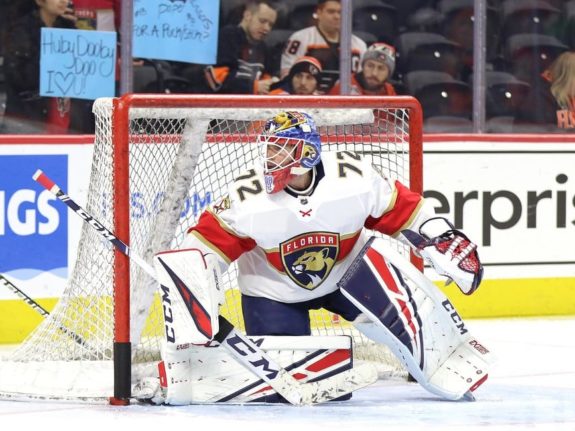Much has changed since the 1917 inception of the NHL. Players are now required to wear helmets, and forward passes are no longer outlawed. However, much has also stayed the same, and one such constant is the evaluation of goaltending.
Three mainstream goalie statistics have maintained perpetual dominance for decades: save percentage (SV%), goals-against average (GAA), and wins. It’s not hard to see why. Each of these stats is not only easy to calculate, but also easily comprehensible to the average fan. It stands to reason that fans would appreciate stats as intuitive as these three.
More recently, however, the norms of hockey evaluation have been challenged with the emergence of what has come to be known as “advanced” stats. For many hockey fans, the mere mention of the phrase will send them running in the opposite direction. Having used only a select few statistics for the entirety of hockey’s existence, not many people are willing to abandon their preconceived notions regarding how to best assess the sport.
That stance is somewhat understandable, and it is why I think that goaltending is the best place to initially introduce advanced metrics. It is a position, unlike those of skaters, that has historically been evaluated using only statistics, so why not try to improve upon that? In this article, I will explain why the relatively new goals saved above expected (GSAx) stat is a better method of evaluating goaltending.
What is GSAx?
To understand the concept of goals saved above expected, one must first understand what expected goals (xG) are. The calculation behind them is relatively simple. Each shot attempt is assigned a numerical value based on the percent chance the shot has of going in. This percentage is based on an abundance of factors, including but not limited to shot distance, shot angle, goalie positioning, number of defensemen present, and number of sticks in the way. Even factors like whether or not there was a cross-crease pass preceding the shot are taken into account.
That percentage is then converted to a decimal (a shot with a 20% chance of going in has an xG value of 0.2). These decimals are accumulated into a team’s or player’s xG total in a game. For example, let’s say Sidney Crosby takes three shot attempts in a game. The first has a 15% chance of going in, the second has a 32% chance, and the third has a 56% chance. Crosby’s xG total for the game would be the total of all three percentages or 1.03 xG.
Applying this concept to goaltending is pretty simple. Let’s say Sergei Bobrovsky plays a game against the Carolina Hurricanes. He allows three goals against, but Carolina’s xG total for the game is only 2.42. To determine Bobrovsky’s GSAx, we subtract 3 from 2.42. His GSAx for the game is -0.58. Not a very good game.

So, the formula for GSAx is expected goals against minus goals against. It may even be a stretch to call this an advanced stat given how simple it really is.
What’s Wrong With the Mainstream Stats?
Now that we’ve gone through what GSAx is, the question must be asked: why is it any better than the stats most of you are probably used to seeing?
The easiest metric to discredit is wins. Although goalies are certainly important factors in all hockey games, wins are team accomplishments. Depending on the caliber of the given team, a goalie could rack up win after win while playing below-average hockey. Wins simply don’t offer much of a reflection on how well a goalie alone has played.
In theory, SV% and GAA seem like effective statistics. The former measures the percentage of shots that are let in by the goaltender, and the latter measures the average number of goals against a goalie allows. Why are those poor methods of evaluation?
The primary reason why these two stats are less effective than GSAx is that they fail to isolate the goaltender, much like wins. Both SV% and GAA can be heavily influenced by the quality of competition (QoC) and quality of teammates (QoT). GSAx, on the other hand, factors in a wide variety of potential external determinants like the ones mentioned above.
It is important to note that hockey is a team sport, and it is therefore impossible to completely isolate any player. However, xG comes reasonably close, and it at least makes a real effort to do so. SV% and GAA have no isolation involved, and so QoC and QoT, along with countless other factors, can skew the data.
There is also one particular scenario in which GSAx is far more useful than any other stat: shutouts. In a shutout, regardless of whether the goaltender faced 50 shots or zero, his stats for the night are .1000 SV% and 0.00 GAA. Using GSAx, the quality of each shutout can be determined. There is a big difference between a shutout with 1.06 GSAx and one with 3.78 GSAx.
Application of GSAx
The point of this article is to explain why GSAx is the best metric available to evaluate goaltenders, so its application may seem rather obvious – doing just that. However, I also want to highlight an example of where it can help to debunk narratives brought on by the flawed mainstream stats.
In 2018-19, Tampa Bay Lightning goaltender Andrei Vasilevskiy won his first Vezina Trophy. To most, this was no surprise, as Vasilevskiy’s mainstream numbers were stellar. He finished near the top of the league in each of the three stats initially mentioned, with 39 wins, a .925 SV%, and a 2.40 GAA. Based solely on those stats, Vasilevskiy was the deserving Vezina winner.

However, if we take a look at GSAx, which, as we have established, better evaluates isolated goaltending performance, Vasilevskiy finished with a mere 7.02 GSAx. Now, this is by no means a bad total, and it was good for 16th league-wide among all goalies. But the Vezina Trophy should not go to the 16th best goaltender in the league.
The deserving Vezina Trophy Winner was John Gibson of the Anaheim Ducks. His basic totals were somewhat weak relative to Vasilevskiy, with 26 wins, a .917 SV%, and a 2.84 GAA, but he also led the league with a lofty 26.9 GSAx.
The discrepancy between mainstream and advanced stats for both goaltenders can be attributed to the quality of the team on which each goaltender played. Vasilevskiy backstopped the Lightning to the President’s Trophy, and the team tied the all-time record of 62 wins. The Ducks, on the other hand, finished 24th in the league with a mere 35 wins.
It may seem arrogant to discredit a Vezina-winning season based on one statistic, but that is the beauty of GSAx. It is an all-encompassing metric. Rather than looking at some combination of the mainstream stats to determine the league’s top goalies, one can simply pluck the name at the top of the GSAx leaderboard because it truly does isolate goaltender performance in the most effective way we have at our disposal.
GSAx in Context
It is also important to understand what qualifies as ‘good’ when using this statistic. Generally, a high-end goaltender will have at least a .915 SV% and a 2.50 GAA. So what is the GSAx equivalent?
In a single game, anything above 1.00 GSAx is a great performance. Any game around 3.00 GSAx is an incredible performance and likely a stolen game. Negative GSAx is a rough night for the goaltender and, more often than not, will cost you the game. GSAx is not overly effective on a game-to-game basis for overall goaltender evaluation, but it can certainly be used to determine how good a single performance was.
Over the course of a full season, a high-quality starting goaltender will get around 10.00 GSAx. A Vezina-worthy performance, in most seasons, is likely around 20.00 GSAx and above. Once again, anything in the negative territory is a bad season.
Conclusion
Advanced stats are not overly popular in the hockey world, but they really aren’t all that complicated. The main obstacle standing in the way of stats such as GSAx entering the mainstream is a lack of understanding, and that’s what this article aims to rectify.
GSAx is a natural progression from the deficiencies of SV%. The latter reflects which goalie saves the most shots; the former reflects which goalie saves the highest-quality shots. Hockey purists should appreciate what GSAx aims to do. In a sense, it quantifies the eye test. If a goalie allows four goals, but seems to have played well based on the eye test, GSAx will reflect that better than any other stat can.
When it comes down to it, GSAx is a simple concept, and it does its job much more effectively than the perpetually dominant goaltending stats. There is no reason not to make the full-time switch. By using it, we can aim to be right more often, and isn’t that what hockey evaluation is all about?
To find GSAx for every season since 2007-08 (the farthest back xG data is available), visit the ‘Goalie Tables’ dropdown under ‘Standard’ at evolvinghockey.com.
(All data via Evolving-Hockey and NHL.com)